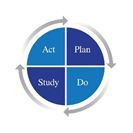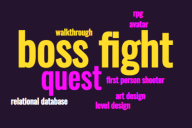The idea of this 3-part blog post series on Digital Baby Steps is to encourage UAS teachers, who would like to produce more online teaching material but find it hard to make time for it, to take very simple steps toward this goal. The aim is to share with you some of the insights I’ve had in my role as a communication teacher teaching Professional English to mainly ICT and Industrial Management students at Metropolia UAS, whilst advancing on my path toward blended learning. If on the other hand you, my reader, are more into taking giant leaps in the world of online learning, I warmly recommend taking a look at the work of Dr Mari Virtanen on ubiquitous learning environments (Virtanen, 2018).
The first part of this series of digital baby steps (Holappa, 2018) dealt with learning to make YouTube videos together with the students in an ad hoc manner during their English lesson. Slightly modified principles of a business concept called MVP (Minimum Viable Product) were applied to carry out the task. In this case, it meant executing the task, from planning and instructing to doing and finalizing, in a very simple manner requiring “the least effort” in order to save everybody’s time and resources.
This second part on digital baby steps concentrates on transforming classroom teaching material into online material suitable for self-study by the students. A simple example is given below.
Identifying teaching content suitable for self-study
In the spring 2019, I spent some time identifying the type of teaching contents of my current English courses that could possibly benefit both the students and me, if put online to be used as self-study material by the students. A significant part of English communication lessons at university level and particularly in universities of applied sciences tends to rely heavily on interactive group exercises performed in class.
Similarly, English is often integrated with substance teaching (Kammonen, 2012) which means that English is used as working language particularly in studies carried out as projects. This kind of integration, also called Content and Language Integrated Learning (CLIL), is currently considered best practice and recommended particularly by The Finnish Network for Language Education Policies and many researchers (see for instance Toivanen & Sankila, 2019). It is of course quite clear it would make no sense to turn any of this type of interactive class activity into online self-study.
However, some of the work that needs to be carried out especially in projects requires structured and concise report writing skills, for example in the form of Bachelor’s/Master’s theses and abstracts. And even though report writing skills can be taught interactively as well, it is a skill that university level students can learn through self-study quite easily. In fact, the current curriculum at Metropolia contains a prerequisite requirement of B2 for English courses on a six-level scale from A1 to A2, B1, B2, C1 and C2 based on CEFR, the Common European Framework of Reference for Languages (Council of Europe, 2019). The students’ ability to adopt and apply the type of discourse needed for academic report writing through online studies is thus mostly very good.
Consequently, writing abstracts was identified as one teaching content suitable for online self-study. For the students, the benefit would be having more freedom in terms of choosing time and place of study. In addition, the teaching would be available as many times as needed. For me, and naturally for the students as well, it would mean that time earlier spent teaching and learning writing skills in the classroom could be used for interactive classwork in the future.
Using PDSA cycle
for a structured and time-saving approach to create the online self-study material
The PDSA cycle (see for instance The W. Edwards Deming Institute, 2019), also known as the Deming cycle, is
a business concept that can be well applied to pedagogical contexts. The PDSA cycle is a model used for continuous quality improvement and it contains four repetitive steps of 1. Plan, 2. Do, 3. Study and 4. Act.

Photo: PDSA cycle (according to The W. Edwards Deming Institute)
The PDSA cycle for creating the online self-study material for the students was the following:
Step 1: Plan (plan how to do what needs to be done)
To plan the online self-study material, I wrote down my requirements including the followin
g five, very simple points:
- Keep it simple and relevant.
- Make use of existing material.
- Include audio only for simplicity, no video.
- Concentrate on being informative (as opposed to being inspirational and motivational).
- Write down a rough script and accept slight mistakes/hesitation for a natural effect.
Step 2: Do (do what needs to be done)
To create the material, I first looked into a few options on how to execute the task at hand and decided to go for a PowerPoint presentation with audio, which basically means making the slides plus recording the script to explain the slides. For my existing slides to work more independently, they needed some tweaking as they did not contain very much text. Therefore, I added informative text on each slide and made sure they followed a strict logic.
After this, I wrote a simple script for each slide and rehearsed speaking out the slides for a few times. Following a full script would have sounded as if I’m reading from a paper and I wanted to avoid that. For recording the slides, I googled ‘how to make Powerpoint slides with audio” and found plenty of short videos that explained what I needed to do. The presentation ended up having 4 slides only and it is approximately 10 minutes long.
Step 3: Study (study outcome by getting feedback)
For this step, it would have been good to ask a few colleagues for feedback, but I decided to get the feedback straight from the students to save time. Consequently, I uploaded the self-study assignment to the school learning management system OMA along with very short and simple feedback questions on clarity, usefulness, user-friendliness and length of slide show. Free commenting was also possible.
The feedback, which exceeded all my expectations, was excellent as seen below:
Scale 1-5, with 5 being the highest
- Clarity 4.8
- Usefulness 4.5
- User-friendliness 4.5
- Length of slide show 4.7 (“Just Perfect!” “In my opinion, the length was good!”)
Surprisingly, the length was not criticized, probably because it was quite clear it couldn’t have been made any shorter. All content was relevant. Similarly, the slides themselves were not criticized. I was expecting the students to recommend adding a talking head, but they didn’t. Instead, this is what they wrote: “I endorse using this format more often.” “I think this method works great.” “A brief but a comprehensive package of easily digestible and very useful content.”
Step 4: Act (act on results of step 3 by identifying corrective measures)
Based on student feedback, it was clear that no critical corrective measures needed to be taken at this point. This is proof of the PDSA cycle working well in simple tasks like this one – thorough planning seems to yield positive results the first time around.
Even though the slides didn’t receive any criticism, I am thinking of making a similar slide show on paraphrasing and making the slides more attractive by following the recommendations by Hannu Turunen in his blog post. To do that, I will go back to Step 1. Plan and then repeat the cycle upto Step 4. Act.
Taking baby steps in creating online teaching material using simple methods is a good idea for anyone with limited time resources. Try it out and you will be positively surprised. So the question is… what teaching contents would you like to put online and how?
Sources:
Council of Europe. 2019. Common European Framework of Reference for Languages (CEFR) Available at: https://www.coe.int/en/web/common-european-framework-reference-languages/table-1-cefr-3.3-common-reference-levels-global-scale
Holappa Sonja. 2018. Digital baby steps 1/3. Co-learning with students in the spirit of MVP. Blogpost. Available at: https://blogit.metropolia.fi/hiilta-ja-timanttia/2018/05/21/1437/
Kammonen Leena. 2012. Englannin opetuksen integrointi ammattikorkeakoulussa. Thesis. HAMK
The W. Edwards Deming Institute. (2019). PDSA Cycle. Available at: https://deming.org/.
Toivanen Kirsi-Marja & Sankila Kaija 2019. The Future is Now – UAS Language Education in Transition. Kieli, koulutus ja yhteiskunta, 10(1). Available at: https://www.kieliverkosto.fi/fi/journals/kieli-koulutus-ja-yhteiskunta-helmikuu-2019/the-future-is-now-uas-language-education-in-transition
Turunen Hannu. 2019. Näin teet hyvän PowerPoint-esityksen. Blogikirjoitus. Available at: https://blogit.metropolia.fi/hiilta-ja-timanttia/2019/01/27/nain-teet-hyvan-powerpoint-esityksen/
Virtanen Mari. 2018. The development of ubiquitous 360° learning environment and its effects on students’ satisfaction and histotechnological knowledge. Doctoral dissertation. Available at: http://jultika.oulu.fi/files/isbn9789526218298.pdf









Ei kommentteja